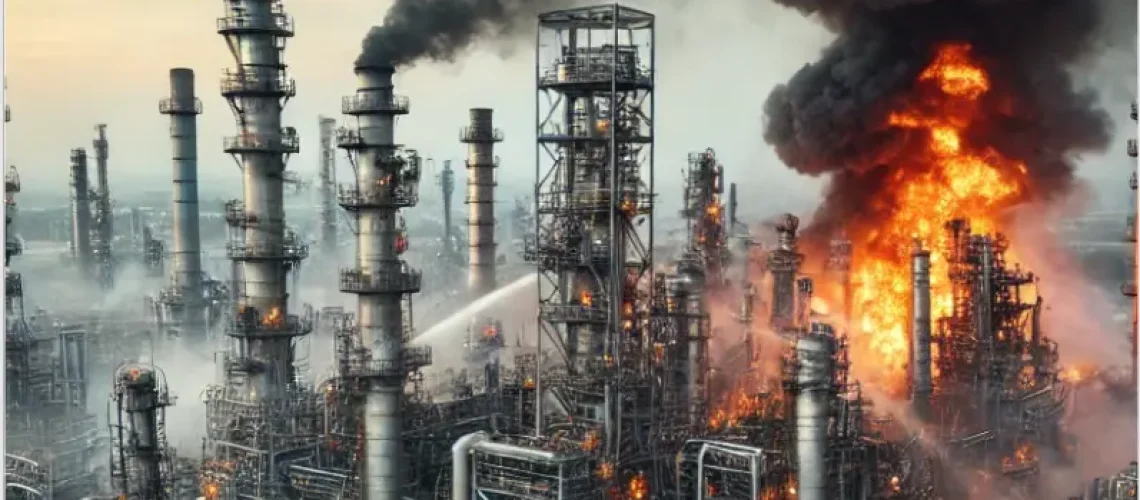Fires in the hydrocarbon industry can vary greatly in their causes, behaviours, and potential consequences. Understanding the different types of fires is crucial for effective fire prevention and control. From pool fires and bund fires to jet fires and flash fires, each presents unique risks and challenges, requiring specific firefighting strategies. In this article, we will explain the introduction of the types of fire. There are different types of fires which can occur in any petroleum industry;
1. Pool Fire
A pool fire occurs when a flammable liquid is spilled and ignited on a flat surface, forming a burning pool. The liquid burns with flames that radiate heat and produce smoke. This type of fire is characterized as a turbulent diffusion flame, burning above a horizontal pool of vaporizing hydrocarbon fuel, with the fuel having little to no initial momentum. Pool fires can either be static, where the fire is contained, or “running” fires that spread across a surface. They pose a significant risk, especially when large quantities of liquid hydrocarbons are involved.
The severity of a pool fire depends on the size of the liquid pool and the type of fuel involved, often leading to high flames and significant heat radiation. Pool fires can cause extensive damage to equipment and structures and pose serious threats to personnel. In process safety, pool fires are evaluated during hazard analyses, such as HAZOP and LOPA, to ensure effective controls are in place to mitigate risks.
2. Jet Fire
A jet fire occurs when a flammable substance, usually a gas or liquid under high pressure, is released from a containment system like a pipe or vessel and ignites. This results in a high-velocity, concentrated flame that burns in the direction of the fuel release. The flame is typically long and narrow, with a high heat release rate. Jet fires are an important consideration in safety assessments like HAZOP studies to ensure appropriate control measures and emergency responses are in place.
A jet fire is a turbulent diffusion flame caused by the combustion of fuel that is continuously released with significant force in one or more specific directions. It can result from the release of gases, liquids, or a two-phase mixture. The characteristics of a jet fire depend on factors such as the fuel composition, release conditions, rate of release, geometry, direction, and surrounding wind conditions. The intense heat fluxes generated by jet fires can lead to structural or vessel/pipework failure, potentially causing further escalation.
3. Flash Fire
A flash fire is a rapidly spreading fire that occurs when a cloud of flammable gas, vapour, or dust ignites, typically after an accidental release. Flash fires are characterized by their quick ignition and short duration, lasting only a few seconds. The flame spreads through the cloud at high speed, consuming the flammable material within the cloud.
Accidental releases of flammable liquids, gases, or even dust and particles, if not immediately ignited, often result in the formation of a vapour cloud. If this cloud encounters an ignition source, the flame spreads rapidly both upwind and downwind. Initially, the flame remains contained within the cloud due to premixed burning in regions within the flammable limits. Eventually, the flame extends upward in the form of a fire plume above the cloud. The downwind edge of the flame moves toward the spill point as it consumes the flammable vapour downwind of the ignition source. Since the duration of this fire is short, the primary damage is caused by thermal radiation and oxygen depletion.
4. Top tank fire
A top tank fire occurs when liquid or vapour burns either inside the tank or on the surface of a floating roof tank. This type of fire can have serious consequences for nearby tanks and can easily escalate. As a result, specific firefighting strategies must be followed to control and mitigate the fire effectively.
5. Bund Fires
A leak or spill into a bund can occur due to the failure of primary containment, overfilling of a tank, or as a result of a boilover. If the spilled substance encounters an ignition source, a bund fire will occur. This type of fire can have serious consequences for nearby tanks and can escalate quickly. Therefore, specific firefighting strategies must be followed to manage and control the situation effectively.





